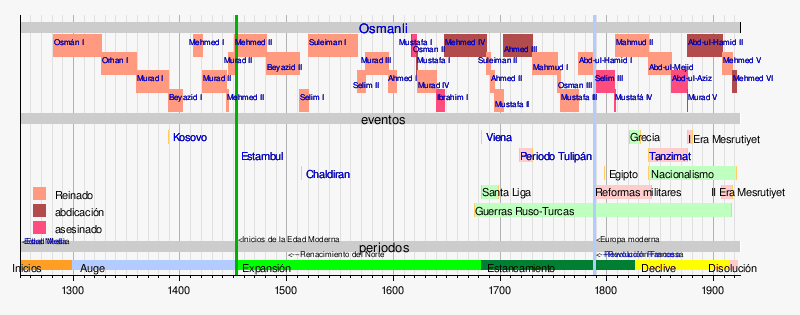The Osmanli dynasty, also called the House of Osman (Ottoman Turkish: خاندان آل عثمان, Ḫānedān-ı Āl-ı ʿOsmān; modern Turkish, Osmanlı Hanedanı), was the ruling family of the Ottoman Empire from its founding in 1299 until its dissolution in 1922.
History

Animation showing the development of the Arabic calligraphy
tughrain this case corresponds to Mahmud II.
According to Ottoman tradition, the Osmanli dynasty can be traced back to a family from the Kayı tribe of the Oğuz Turks. The dynasty originated from the bey (leader) of the Kayı tribe, highlighting Ertuğrul, who was assigned by the Sultanate of Rum with the domain of Söğüt and its surroundings, in northwestern Anatolia (present-day province of Bilecik, Turkey), near the border area with the Byzantine Empire. His son, Osman, declared independence from the Seljuks of Rum in 1299, formally beginning the Ottoman Empire. Both the dynasty and the empire it spawned are named after him in his honor.
Over the following centuries, Osman's small domain grew into a sultanate that spanned three continents. In 1383, the third monarch of the dynasty, Murad I, declared himself sultan, a title the rulers would hold until the dissolution of the empire. However, this title was also awarded to his predecessors posthumously.
Succession in the Ottoman dynasty initially took place among the various sons of the sultan regardless of age. This led to fights
civil wars or real massacres (the so-called law of fratricide). After Mehmed III, who had 19 brothers executed at the time of his accession to the throne, the Seniorate system was introduced, which recognized the right of succession to the eldest male member of the family, locked up, along with the other princes, in a separate area of the palace.
Deposition
The sultanate was abolished in 1922 by the nationalist government that emerged triumphant from the Turkish War of Independence, forcing Sultan Mehmed VI into exile, and establishing a republic in Turkey over the remnants of the Ottoman Empire after its dissolution. Although the establishment of the republic ended the political power of the Ottoman dynasty, it maintained religious power for a few months under the figure of Abdülmecid II, who remained caliph until 1924, when the secularizing government of Kemal Atatürk formally abolished the caliphate. Members of the Osmanli dynasty were initially declared persona non grata. Over the years, some members of the dynasty have been able to return to Turkey, albeit as ordinary citizens. Civilly, the descendants of the Osmanli dynasty have adopted the surname Osmanoğlu.
Dynastic List
| N.o
| Portrait
| Name
| Tuğra
| Home
| Fin
| Notes
| R.
|
|---|
| 1
|  | Osman I El Guerrero
(1258-1326)
Osman Gazi | -
| c. 1299
| c. 1326
| - Son of Bey Ertuğrul
- Declared its independence from the Sultanate of Rum
| |
| 2
|  | Orhan El Guerrero
(1281-1362)
Orhan Gazi |  | c. 1326
| c. 1359
| - Extended its control to the northwest end of Anatolia
- He participated in the Byzantine Civil War of 1341-1347 in favor of Juan VI Cantacuceno, usurper of Juan V.
| |
| 3
| 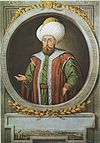 | Murad I The Divine
(1326-1389)
Murad-ı Hüdavendigâr |  | c. 1359
| 15 June 1389
| - First to hold Sultan
- Dead in the Battle of Kosovo
| |
| 4
|  | Bayezid I The Ray
(1354-1403)
Yıldırım Bayezid |  | 15 June 1389
| 20 July 1402
| - Captured in the Battle of Angora against the Timid Empire
- Dead on 8 March 1403
| |
| - Ottoman Interregno —
|
|---|
| 5
|  | Mehmed I The Noble
(1389-1421)
Çelebi Mehmed |  | 5 June 1413
| 26 May 1421
| - Reunified the sultanato after winning at the Battle of Çamurlu
- Expanded Ottoman control to Valaquia and Albania
| |
| 6
|  | Murad II
(1404-1451) |  | 26 May 1421
| 1 December 1444
| - He took Thessalonica and entered Greece and Macedonia
- He faced the Varna Crusade
- Retired left his son Murad II on the throne
| |
| 7
| 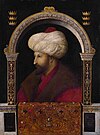 | Mehmed II The Conqueror
(1432-1481)
Fatih Sultan Mehmed |  | 1 December 1444
| September 1445
| - Named sultan in 1444, with only twelve years of age
| |
| 6
|  | Murad II
(1404-1451) |  | September 1445
| 3 February 1451
| - He took Thessalonica and entered Greece and Macedonia
- He faced the Varna Crusade
| |
| 7
|  | Mehmed II The Conqueror
(1432-1481)
Fatih Sultan Mehmed |  | 3 February 1451
| 3 May 1481
| - Proclaimed "César de Rome" after the conquest of Constantinople in 1453
| |
| 8
|  | Bayezid II
(1447-1512) |  | 21 May 1481
| 25 April 1512
| - Abdicted the throne
- Death on 26 May 1512
| |
| 9
| 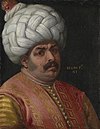 | Selim I The Shadow
(1470-1520)
Yavuz Selim |  | 25 April 1512
| 22 September 1520
| - Conquered the Mediterranean Levant, Egypt and the Hiyaz
- First califa of the Empire
| |
| 10
|  | Süleyman I The Magnificent
(1494-1566)
Muhteşem Süleyman |  | 30 September 1520
| 6 September 1566
| - His reign — the longest — marked the apogee of the Empire
- Died for natural causes during the Szigetvár Site
| |
| 11
|  | Selim II The Blonde
(1524-1574)
Sarı Selim |  | 6 September
1566
| 12 December1574
| - J. Hammer-Purgstall (1774-1856)
- Ismail Hami Danismend (1899-1967)
- Eduard von Zambaur (1886-1947)
| |
| 12
| 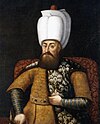 | Murad III
(1546-1595) |  | 12 didle
1574
| 15 eNero of
1595
| - This sultan left power on December 10, 1583, to his wife Safiye Sultan who took over the Empire during most of his reign.
| |
| 13
| 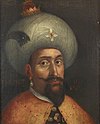 | Mehmed III The Righteous
(1566-1603)
Adlî Mehmed |  | 15 eNero of
1595
| 22 didle of 1603
| - It was the only sultan who did not reign or use power since he preferred to focus on the harem while his Mother Safiye Sultan or Queen Sofia took over the Empire throughout his reign.
| |
| 14
|  | Ahmed I El Afortunado
(1590-1617)
Bahtî Ahmed |  | 22 Decembere of
1603
| 22 November
1617
| | |
| 15
| 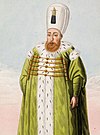 | Mustafa I
(1592-1639) |  | 22 November 1617
| 26 February 1618
| - Deposed in favor of your nephew
| |
| 16
|  | Osman II The Young
(1602-1622)
Genç Osman |  | 26 February 1618
| 19 May 1622
| - Elevated to the throne with 14 years
| |
| 17
|  | Murad IV
(1612-1640) |  | 10 September 1623
| 9 February 1640
| - Restored the authority and power of the Ottoman Empire
- Conqueror of Baghdad
- Conqueror of Yerevan
| |
| 18
|  | İbrahim
(1615-1648) |  | 9 February 1640
| 8 August 1648
| - Budget
- Executed on 18 August 1648
| |
| 19
|  | Mehmed IV The Hunter
(1642-1693)
Avcı Mehmed |  | 8 August 1648
| 8 November 1687
| - After the Ottoman defeat at the Battle of Mohács (1687)
- Death on 6 January 1693
- Second longer reign
| |
| 20
|  | Süleyman II
(1642-1691) |  | 8 November 1687
| 22 June 1691
| | |
| 21
|  | Ahmed II
(1643-1695) |  | 22 June 1691
| 8 February 1695
| | |
| 22
|  | Mustafa II
(1664-1703) |  | 8 February 1695
| 22 August 1703
| - Deposed in a Jesuit revolt
- Death on 30–31 December 1793
| |
| 23
|  | Ahmed III
(1673-1736) |  | 22 August 1703
| 1 October 1730
| - Defeated in the Great Turkish War
- Deposed to the jenízars
- Death on 1 July 1736
| |
| 24
| 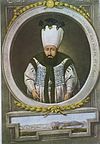 | Mahmud I
(1696-1754) |  | 1 October 1730
| 13 December 1754
| | |
| 25
|  | Osman III
(1699-1757) |  | 13 December 1754
| 30 October 1757
| | |
| 26
| 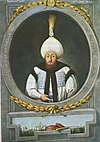 | Mustafa III
(1717-1774) |  | 30 October 1757
| 21 January 1774
| - Remembered to reform the army
| |
| 27
| 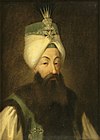 | Abdülhamid I
(1725-1789) |  | 21 January 1774
| 7 April 1789
| - Defeated in the Russian-Turkish War of 1787-1792
| |
| 28
| 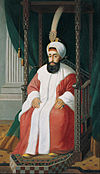 | Selim III
(1761-1807) |  | 7 April 1789
| 29 May 1807
| - Allied of Great Britain during the Napoleonic campaign in Egypt
- Deposed in a revolt in response to his attempts to reform
| |
| 29
| 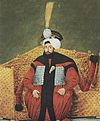 | Mustafa IV
(1779-1808) |  | 29 May 1807
| 28 July 1808
| | |
| 30
|  | Mahmud II
(1785-1839) |  | 28 July 1808
| 1 July 1839
| - Defeated in the Russian-Turkish War of 1806-1812
- He highlighted his important bureaucratic and military reforms
- The Empire Lost All Greece
| |
| 31
|  | Abdülmecid I
(1823-1861) |  | 1 July 1839
| 25 June 1861
| - His reign continued the process of "reorganization" (Tanzimat)
| |
| 32
| 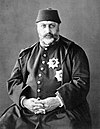 | Abdülaziz
(1830-1876) |  | 25 June 1861
| 30 May 1876
| - First Sultan to visit Europe
- Abdicated in the midst of popular discontent and economic crisis
- He committed suicide (?) on 4 June
| |
| 33
|  | Murad V
(1840-1904) |  | 30 May 1876
| 31 August 1876
| - I bet after I found out I had a mental illness.
- Death on 29 August 1904
| |
| 34
|  | Abdülhamid II
(1842-1918) |  | 31 August 1876
| 27 August 1909
| - It proclaimed the first constitution, but it resisted the change until 1908 (Revolution of the Young Turks)
- Egypt was yielded to the British
- Death on 10 February 1918
| |
| 35
|  | Mehmed V Reşad
(1844-1918) |  | 27 August 1909
| 3 July 1918
| - He reigned as a constitutional monarch, giving his powers to the Union and Progress Committee
- Defeated in Balkan Wars and World War I
| |
| 36
|  | Mehmed VI Vahîdeddin
(1861-1926) |  | 3 July 1918
| 1 November 1922
| - His reign saw the immediate dissolution and partition of the Empire
- Death on 16 May 1926, exiled in the Kingdom of Italy
| |
| Caliph under the Republic of Turkey (1922–1924)
|
|---|
|  | Abdülmecid II
(1868-1944) | -
| 18 November 1922
| 3 March 1924
| - Crown Prince of Mehmed VI
- Elected by the Turkish Grand National Assembly
- exiled after the abolition of the Caliphate
- Death on 23 August 1944 in the French Republic
| |
Heads of the dynasty after 1922
| N.o
| Image
| Name
| Notes
| Home
| End / Death
| R.
|
|---|
| 36
|  | Mehmed VI
| Sultan between 1918 and 1922
| 1 November 1922
| 16 May 1926
| |
| 37
|  | Abdülmecid II
| Son of Sultan Abdülaziz;
Last Ottoman caliph
| 16 May 1926
| 23 August 1944
| |
| 38
|  | Ahmed Nihad Osmanoğlu
| Nieto de Murad V
| 23 August 1944
| 4 June 1954
| |
| 39
|  | Osman Füad Osmanoğlu
| Nieto de Murad V
| 4 June 1954
| 19 May 1973
| |
| 40
| -
| Mehmed Abdülaziz Osmanoğlu
| Nieto de Abdülaziz
| 1973
| 1977
| |
| 41
| | Ali Vâsıb Osmanoğlu
| Bisnieto de Murad V
| 1977
| 1983
| |
| 42
|  | Orhan Osmanoğlu
| Nieto de Abdülhamid II
| 1983
| 1994
| |
| 43
| -
| Ertuğrul Osmanoğlu
| Nieto de Abdülhamid II
| 1994
| 2009
| |
| 44
| -
| Bayezid Osmanoğlu
| Bisnieto de Abdülmecid
| 23 September 2009
| 7 January 2017
| |
| 45
| -
| Dündar Osmanoğlu
| Bisnieto of Abdülhamid II
| 7 January 2017
| 18 January 2021
| |
| 46
|  | Harun Osmanoğlu | Brother of the former
| since 18 January 2021 | |
Chronological table
Más resultados...
